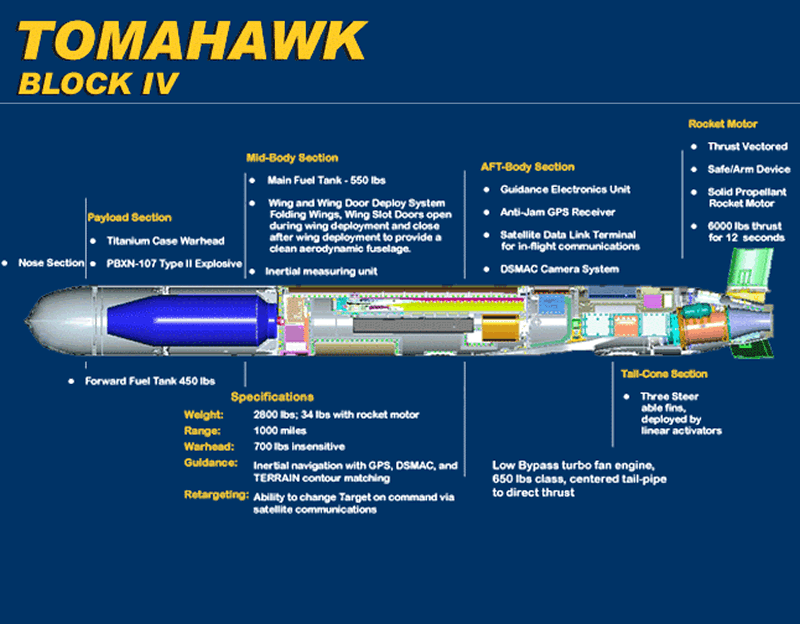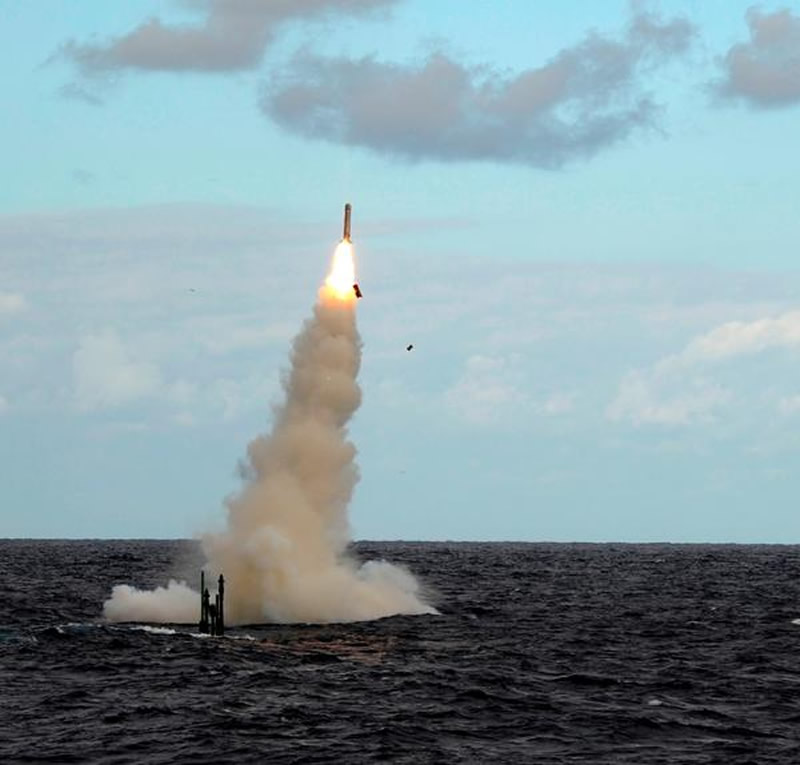El extensamente probado en combate misil de crucero táctico TOMAHAWK, en servicio en la US Navy desde los 80´s, muestra su vigencia luego de 40 años, al desarrollarse la versión Block V del mismo. Esta modernización que extendería su vida útil en unos 15 años, proporciona al misil revolucionarias mejoras, tales como la capacidad de sobrevolar la zona objetivo en espera de la orden de ataque (“loitering”), así como cambiar instantáneamente de blancos a requerimiento.
Block IV Tomahawk is the current generation of the Tomahawk family of cruise missiles. The BGM-109 Tomahawk family began life in the 1980s as sub-sonic, low-flying nuclear strike weapons, before being developed into long-range RGM/UGM-109 conventional attack missiles. They’re most frequently launched from submarines and surface ships, and have been the US Navy’s preferred option for initial air strikes in Iraq, Libya, et. al. Britain has also bought Tomahawk missiles, and launches them exclusively from submarines.
Block IV is the latest variant. It adds innovative technologies that improve combat flexibility, while dramatically reducing the costs to buy, operate, and support these missiles. That’s why the Block IV program, under US Navy PMA-280, has been one of the USA’s defense acquisition success stories over the last decade.
xGM-109: Missile & Launcher Types
Tomahawk missiles have become the US Navy’s major land strike missile. The USA has bought more than 4,000 over the years, and March 2011 saw the 2,000th GM-109 Tomahawk fired in combat, from USS Barry [DDG 52]. The missile typically flies at 50 – 100 feet above ground using terrain-following radar, and navigates to its targets using a combination of GPS/INS, computer matching of the land’s radar-mapped contours to the missile’s internal maps (TERCOM), and final matching of the target scene (DSMAC). Once on target the missile can fly a direct horizontal attack mode, trigger preprogrammed detonation above the target, or use a pop-up and dive maneuver. CEP is often described as being about 10 meters.

There are 3 fielded variants.
The xGM-109C/D Block III missiles will serve in the US Navy until FY 2020, and can be fitted with either a 1,000 pound unitary conventional warhead (xGM-109C), or a conventional submunitions warhead with hundreds of smaller bomblets (xGM-109D). The Tomahawk Block III has a 750 nautical mile range. Unfortunately, mission planning requires 80 hours of work.
The xGM-109E Tomahawk Block IV achieved Initial Operating Capability in 2004, and current Pentagon plans will end purchases in 2015. Block IV reportedly increases missile range to 900 nautical miles, but it only uses the unitary warhead. Mission planning has been cut from 80 hours to just 1 hour, which makes a big difference to combat usage. The missile also has a 2-way UHF SATCOM datalink that allows the missile to be redirected in flight, or commanded to loiter over an area and wait for instructions from a Fleet HQ’s Maritime Operations Center.
Submarine Launch 109
Submarine-launched UGM-109 missiles are more expensive than their ship launched RGM-109 VLS counterparts, because the submarines’ launch mechanism is more involved and more strenuous. UGM-109 “all-up-round” storage and interface canisters come in 2 types: CLS and TTL. CLS canisters launch UGM-109s from vertical launch tubes installed on many of America’s Los Angeles Class (SSN 719 on), all Virginia Class, and all SSGN Ohio Class submarines. TTL canisters are used to launch Tomahawk missiles from a submarine’s torpedo tubes, which is Britain’s preferred method.
In both cases, a Tomahawk launches “wet”, unlike most anti-ship missiles. The canister remains in the vertical-launch or torpedo tube, while the missile is ejected. Once the UGM-109 has reached a safe distance from the submarine, its rocket booster ignites underwater to power it airborne. That booster falls away just before the missile ignites its jet engine. If the submarine needs to “clear the tube” for torpedoes, anti-ships missiles, mines, UUVs, etc., TTL canisters can be ejected into the sea after launch, as a separate evolution. In contrast, CLS vertical-launch canisters are only removed portside, when the submarine comes into base for servicing and reloading.
Tomahawk: The 2019 Evolution
There was a plan to develop a successor to the retired xGM-109B ship-killer by 2015, as an interim capability for the US Navy’s Offensive Anti-Surface Warfare (OASuW) program. That was shelved in the FY 2014 budget, as the Navy opted to drop the interim capability. Instead, they’re moving ahead with OASuW’s main xGM-84 Harpoon missile replacement program for air and sea launch. The LRASM derivative of Lockheed Martin’s subsonic but stealthy AGM-158B JASSM-ER is the initial air-launched missile, but there will be competition for air and naval missiles beyond FY 2019.
Raytheon has partnered with Norway’s Kongsberg to offer the stealthy, and accurate JSM for the air-launched OASuW, and their entry has the unique ability to fit inside the F-35C’s weapon bays. They could also offer Kongsberg’s NSM counterpart in the naval realm, but that would leave Tomahawk in the cold. Or would it?
The key to the next set of Tomahawk improvements is actually a warranty. The missile has a 15-year warranty and a 30-year service life, so 2019 will begin a recertification cycle for the fleet that could last until 2030. Threats continue to evolve, so why not add some missile upgrades while they’re back in the shop anyway? The US Navy already has a specifications sheet of possible improvements, and they’ve done a number of capability studies.
Raytheon is investing almost $40 million of its own funds in parallel, and they’re still talking to the Navy about that final package, which will break down into 3 broad categories.
Anti-Access/ Area Denial Communications Suite. Saddam Hussein had a sophisticated anti-aircraft system, but he didn’t have the kind of high-end jamming and emissions triangulation capabilities expected of future opponents. The challenge is twofold: keep the enemy from cutting off your communications, and keep your communications from alerting the enemy.
One option that has been mentioned in public involves adding a Line Of Sight datalink capability. The flip side of that move would involve training and tactics changes that push missile control farther down the command chain. That may be necessary, but is the US Navy comfortable doing that? There’s more to these A2/AD-CS discussions than just picking technologies.
Autonomy. The Tomahawk is already an autonomous weapon, in the sense that it can be fired at pre-planned fixed targets and left alone. To remain relevant, it needs to add dynamic terminal autonomy: the ability to acquire targets on its own and hit them, even if the target is moving or has moved. It would also be useful to expand the missile’s navigation autonomy, by offering backups for hardened SASSM M-code GPS.
Both kinds of upgrades are being contemplated. Early tests that aren’t autonomous involve Rapid In-flight Target Update, which allows units that have a lock on a target to transmit rapid final scene updates for the missile’s DSMAC guidance. This is still done via Fleet HQ as Standard Operational Procedure, but that’s enough to hit moving targets in some circumstances. Ships would become vulnerable to Tomahawk strikes if the targeting platform can survive their defenses, and the same is true for land-based air defense systems that can repeatedly move to new fixed locations.
Raytheon and the Navy are looking for more, with a focus on mature technologies to cut down program risk. An ESM system for noticing and geolocating emissions has already begun testing. Raytheon personnel stress its quality, to the point that Navigation via Signals of Opportunity (NAVSOP) might be possible as a backup to GPS. During the attack run, ESM can allow the Tomahawk to home in on an active enemy ship or air defense radars, or even on other intercepted signals. That begins to add autonomous moving target capability, and the firm plans to take the next step by flight testing a dual-mode ESM/ active radar seeker system before the end of 2014. Finally, passive visual spectrum (camera or imaging infrared) guidance has also become popular for long-range strike missiles, because it doesn’t give the missile’s location away by creating electro-magnetic emissions. Raytheon has confirmed that CCD/IIR upgrades are also under consideration for Tomahawk, but stressed that no final decisions have been made about a future guidance package.
Core Strengthening. All of these capabilities are great, but they demand more computer processing power, more memory, more onboard power, etc. The missile’s core will need redesigns, in order to keep up.
Raytheon had to develop a Multi-Function Modular Processor to handle those computing needs. Other efforts will look to add new technology, like the Joint Multiple Effects Warhead System (JMEWS) warhead to allow mid-flight reprogramming, and improve performance against reinforced targets like bunkers. Still other attempts will take advantage of existing upgrades. As an example of the latter, Block III introduced the ability to throttle the missile’s Williams F107-WR-402 turbofan, and Raytheon has been expanding its usefulness over time. It’s a capability that’s obviously handy for adjusting the missile’s time of arrival, or extending range, but the firm has recently been testing a “high speed dash” mode. It’s still subsonic, but it represents some impressive flying that close to the ground.
The Missing Link
Even after all of these upgrades, the Tomahawk is still a 1970s design that relies on low altitude to hide from radar. That isn’t really subject to change, even though downward-looking radars are proliferating on small AWACS planes and aerostat blimps, and radars in modern ships and air defense systems are taking big steps forward.
All of the Tomahawk’s proposed technologies are well and good, and they will expand the missile’s usefulness substantially. Adding them to thousands of existing missiles is very cost effective, and makes a great deal of sense. As budget crunches force the Navy to re-examine every aspect of their programs, however, the Navy will have to make decisions about the cost, capability profile, and limitations of every weapon in their arsenal. Raytheon is trying to position Tomahawk as best they can, but the final decisions will lie elsewhere.


